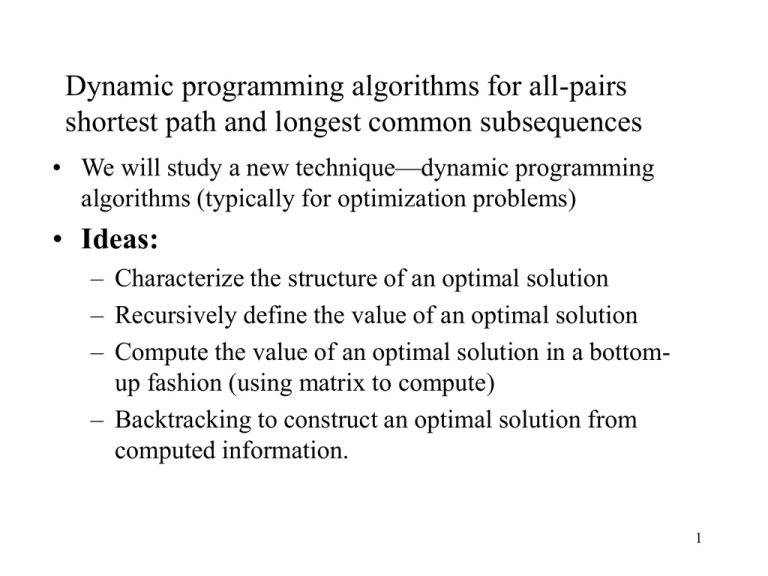lecture66
advertisement

Dynamic programming algorithms for all-pairs
shortest path and longest common subsequences
• We will study a new technique—dynamic programming
algorithms (typically for optimization problems)
• Ideas:
– Characterize the structure of an optimal solution
– Recursively define the value of an optimal solution
– Compute the value of an optimal solution in a bottomup fashion (using matrix to compute)
– Backtracking to construct an optimal solution from
computed information.
1
Floyd-Warshall algorithm for
shortest path:
• Use a different dynamic-programming
formulation to solve the all-pairs shortest-paths
problem on a directed graph G=(V,E).
• The resulting algorithm, known as the FloydWarshall algorithm, runs in O (V3) time.
– negative-weight edges may be present,
– but we shall assume that there are no negativeweight cycles.
2
The structure of a shortest path:
• We use a different characterization of the structure of a
shortest path than we used in the matrix-multiplicationbased all-pairs algorithms.
• The algorithm considers the “intermediate” vertices of a
shortest path, where an intermediate vertex of a simple
path p=<v1,v2,…,vl> is any vertex in p other than v1 or vl,
that is, any vertex in the set {v2,v3,…,vl-1}
3
Continue:
• Let the vertices of G be V={1,2,…,n}, and consider a
subset {1,2,…,k} of vertices for some k.
• For any pair of vertices i,j V, consider all paths from i to
j whose intermediate vertices are all drawn from
{1,2,…,k},and let p be a minimum-weight path from
among them.
• The Floyd-Warshall algorithm exploits a relationship
between path p and shortest paths from i to j with all
intermediate vertices in the set {1,2,…,k-1}.
4
Relationship:
• The relationship depends on whether or not k is an
intermediate vertex of path p.
• If k is not an intermediate vertex of path p, then all
intermediate vertices of path p are in the set {1,2,…,k-1}.
Thus, a shortest path from vertex i to vertex j with all
intermediate vertices in the set {1,2,…,k-1} is also a
shortest path from i to j with all intermediate vertices in the
set {1,2,…,k}.
• If k is an intermediate vertex of path p,then we break p
p1
p2
down into i
k
j as shown Figure 2.p1 is a
shortest path from i to k with all intermediate vertices in
the set {1,2,…,k-1}, so as p2.
5
All intermediate vertices in {1,2,…,k-1}
p1
i
k
p2
j
P:all intermediate vertices in {1,2,…,k}
Figure 2. Path p is a shortest path from vertex i to vertex j,and
k is the highest-numbered intermediate vertex of p. Path p1,
the portion of path p from vertex i to vertex k,has all intermediate
vertices in the set {1,2,…,k-1}.The same holds for path p2 from
vertex k to vertex j.
6
A recursive solution to the allpairs shortest paths problem:
• Let dij(k) be the weight of a shortest path from vertex i to
vertex j with all intermediate vertices in the set {1,2,…,k}.
A recursive definition is given by
• dij(k)= wij
if k=0,
•
min(dij(k-1),dik(k-1)+dkj(k-1))
if k 1.
• The matrix D(n)=(dij(n)) gives the final answer-dij(n)= (i, j )
for all i,j V-because all intermediate vertices are in the
set {1,2,…,n}.
7
Computing the shortest-path
weights bottom up:
•
•
•
•
•
•
•
FLOYD-WARSHALL(W)
n
rows[W]
D(0)
W
for k
1 to n
do for i
1 to n
do for j
1 to n
dij(k)
min(dij(k-1),dik(k-1)+dkj(k-1))
• return D(n)
8
Example:
• Figure 3
2
4
3
1
3
8
1
-4
2
7
5
6
-5
4
9
0 3 8 4
0 1 7
4 0
(0)
D =
2 5 0
6 0
1
NIL 1
NIL 1
2
NIL NIL NIL 2
NIL 3
NIL
NIL
NIL
(0)
=
NIL 4
NIL NIL
4
NIL NIL NIL 5
NIL
0 3 8 4
0 1 7
4 0
D(1)=
2 5 5 0 2
6 0
1
NIL 1
NIL 1
2
NIL NIL NIL 2
(1)= NIL 3 NIL NIL NIL
1
4
NIL 1
4
NIL NIL NIL 5
NIL
10
0 3 8
0
4 0
(2)
D =
2 5 5
4 4
1 7
5 11
0 2
6 0
1
2
1
NIL 1
2
NIL NIL NIL 2
NIL 3
NIL
2
2
(2)
=
1
4
NIL 1
4
NIL NIL NIL 5
NIL
8
0 3
0
4
0
(3)
D =
2 1 5
4 4
1 7
5 11
0 2
6 0
1
2
1
NIL 1
2
NIL NIL NIL 2
(3)= NIL 3 NIL 2 2
3
4
NIL 1
4
NIL NIL NIL 5
NIL
11
0 3 1 4 4
3 0 4 1 1
7 4
0
5
3
(4)
D =
2 1 5 0 2
8 5
1 6 0
4
2
1
NIL 1
NIL 4
2
1
4
4
3
NIL
2
1
(4)
=
3
4
NIL 1
4
4
3
4
5
NIL
0 1 3 2 4
3 0 4 1 1
7 4
0 5 3
D(5)=
2 1 5 0 2
8 5
1
6
0
4
5
1
NIL 3
NIL 4
2
1
4
(5)= 4 3 NIL 2 1
3
4
NIL 1
4
4
3
4
5
NIL
12
Comparison of two strings
• Longest common subsequence
• Shortest common supersequence
• Edit distance between two sequences
13
1. Longest common subsequence
• Definition 1: Given a sequence
X=x1x2...xm, another sequence Z=z1z2...zk is
a subsequence of X if there exists a strictly
increasing sequence i1i2...ik of indices of X
such that for all j=1,2,...k, we have xij=zj.
• Example 1: If X=abcdefg, Z=abdg is a
subsequence of X.
X=abcdefg,
Z=ab d g
14
• Definition 2: Given two sequences X and
Y. A sequence Z is a common subsequence
of X and Y if Z is a subsequence of both X
and Y.
• Example 2: X=abcdefg and Y=aaadgfd.
Z=adf is a common subsequence of X and
Y.
X=abc defg
Y=aaaadgfd
Z=a d f
15
• Definition 3: A longest common
subsequence of X and Y is a common
subsequence of X and Y with the longest
length. (The length of a sequence is the
number of letters in the seuqence.)
• Longest common subsequence may not
be unique.
16
Longest common subsequence problem
• Input: Two sequences X=x1x2...xm, and
Y=y1y2...yn.
• Output: a longest common subsequence of X and
Y.
• A brute-force approach
Suppose that mn. Try all subsequence of X
(There are 2m subsequence of X), test if such a
subsequence is also a subsequence of Y, and select
the one with the longest length.
17
Charactering a longest common
subsequence
• Theorem (Optimal substructure of an LCS)
• Let X=x1x2...xm, and Y=y1y2...yn be two
sequences, and
• Z=z1z2...zk be any LCS of X and Y.
• 1. If xm=yn, then zk=xm=yn and Z[1..k-1] is an LCS
of X[1..m-1] and Y[1..n-1].
• 2. If xm yn, then zkxm implies that Z is an LCS
of X[1..m-1] and Y.
• 2. If xm yn, then zkyn implies that Z is an LCS of
X and Y[1..n-1].
18
The recursive equation
• Let c[i,j] be the length of an LCS of X[1...i] and
X[1...j].
• c[i,j] can be computed as follows:
0
if i=0 or j=0,
c[i,j]= c[i-1,j-1]+1
if i,j>0 and xi=yj,
max{c[i,j-1],c[i-1,j]} if i,j>0 and xiyj.
Computing the length of an LCS
• There are nm c[i,j]’s. So we can compute them in
a specific order.
19
The algorithm to compute an LCS
•
•
•
•
•
•
•
•
•
•
•
•
•
•
•
•
1. for i=1 to m do
2.
c[i,0]=0;
3. for j=0 to n do
4.
c[0,j]=0;
5. for i=1 to m do
6.
for j=1 to n do
7.
{
8.
if xi ==yj then
9.
c[i,j]=c[i-1,j-1]=1;
10
b[i,j]=1;
11.
else
if c[i-1,j]>=c[i,j-1] then
12.
c[i,j]=c[i-1,j]
13.
b[i,j]=2;
14.
else c[i,j]=c[i,j-1]
15.
b[i,j]=3;
14
}
20
Example 3: X=BDCABA and Y=ABCBDAB.
21
Constructing an LCS (back-tracking)
• We can find an LCS using b[i,j]’s.
• We start with b[n,m] and track back to some cell b[0,i] or b[i,0].
• The algorithm to construct an LCS
1.
2.
3.
4.
i=m
j=n;
if i==0 or j==0 then exit;
if b[i,j]=1 then
{
i=i-1;
j=j-1;
print “xi”;
}
5. if b[i,j]==2
i=i-1
6. if b[i,j]==3
j=j-1
7. Goto Step 3.
• The time complexity: O(nm).
22
2. Shortest common supersequence
• Definition: Let X and Y be two sequences.
A sequence Z is a supersequence of X and
Y if both X and Y are subsequence of Z.
• Shortest common supersequence
problem:
Input: Two sequences X and Y.
Output: a shortest common supersequence of X
and Y.
23
Recursive Equation:
• Let c[i,j] be the length of an LCS of X[1...i]
and X[1...j].
• c[i,j] can be computed as follows:
j
if i=0
i
if j=0,
c[i,j]= c[i-1,j-1]+1
if i,j>0 and xi=yj,
min{c[i,j-1]+1,c[i-1,j]+1} if i,j>0 and xiyj.
24
25
3. Edit distance between two
sequences
Three operations:
• insertion: inserting an x into abc (between
a and b), we get axbc.
• deletion: deleting b from abc, we get ac.
• replacement: Given a sequence abc,
replacing a with x, we get xbc.
26
Definition: Suppose that we can use three edit operations
(insertion, deletion, and replacement) to edit a sequence
into another. The edit distance between two sequences is
the minimum number of operations required to edit one
sequence into another.
• Note: each operation is counted as 1.
Weighted edit distance:
• There is a weight on each operation.
• For example: s(a,b)=1, s(a, _)=1.5, s(b,a)=1, s(b,_)=1.5.
• Where the weight comes from:
• For DNA and protein sequences, it is from statistics.
27
Alignment of sequences -- an
alternative
• An alignment of two sequences is obtained by inserting
spaces into or at either end of X and Ysuch that the two
resulting sequences X’ and Y’ are of the same length.
That is, every letter in X’ is opposite to a unique letter in
n
Y’.
s( X '[i],Y '[i])
• The alignment value is defined as i 1
• where X’[i] and Y’[i] denote the two letters in column i
of the alignment and s(X’[i], Y’[i]) is the score (weight)
of these opposing letters.
• There are several popular socre schemes for DNA and
protein sequences.
28
• Facts: The edit distance between two sequences is
the same as the alignment value of two sequences
if we use the same score scheme.
• Recursive equation:
c[i,j]=min{ c[i-1, j-1]+s(X[i], Y[j]), c[i, j-1]+s(_,Y[j]),
c[i-1, j)+s(X[i],_)}.
• Time and space complexity
Both are O(nm) or O(n2) if both sequences have equal
length n.
• Why?
We have to compute c[i,j] (the cost) and b[i,j] (for backtracking). Each will take O(n2).
29
Linear space algorithm
• Hints: Computing c[i,j] needs linear space
whereas back-tracking needs O(nm) time.
30
• To compute c[i,j], we need c[i-1,j-1], c[i,j1], & c[i-1,j].
• So, to get c[n,m], we only have to keep
dark cells.
• However, if we do not have all the b[i,j]’s,
we can not get the alignment (nor the edit
process, the subsequence, the
supersequence).
31
• Discussion: Each time we only keep a few
b[i,j]’s and we can re-compute the b[i,j]’s
again. In this way, we can get a linear space
algorithm. However, the time complexity is
increased to O(n3).
32
• A Better Idea: find a cuting point.
• For the problems of smaller size, we do the
same thing until one of the segment
contains 1 letter.
• Key: each time, we fix the middle point
(n/2) of X.
33
• Example: X=abcdefgh and Y=aacdefhh.
• Score scheme: match -- 0 and mismatch
-- 1.
The alignment
abcdefgh
aacdefhh
/|\
cutting point (4,4).
abcd
aacd
efgh
efhh
34
Finding the cutting point:
Let X=x1x2x3...xn and Y=y1y2y3...ym.
Define XT=xnxn-1...x1 and YT=ymym-1 ...y1.
Let c[i,j] be the cost of optimal alignment for X[1...i]
and Y[1...j] and cc[k,l] be the cost of optimal
alignment for XT[1...k] and YT[1...l].
for (i=1, i<=n i++)
if( (c[[n/2], i]+cc[n-[n/2], m-i]) ==c[n,n])
point = i;
We need to check two rows, c[[n/2],1],
c[[n/2],2], ...c[[n/2],m] and cc[n-[n/2], 1], cc[n[n/2],2], ... cc[n-[n/2],m]. O(m) space.
35
The algorithm
1. compute c[n,n], the [n/2]-th row and the ([n/2]+1)-th row
of c.
2. find the cutting point ([n/2], i) as shown above.
3. if i-[n/2] == 1 then compute the alignment of X[1...[n/2])
and Y[1...i].
4. if n-[n/2]+1 == 1 then compute the alignment of
X[[n/2]+1...n] and Y[i+1...n].
5. if i-[n/2] != 1 and n-[n/2]+1 !=1 then
recursive on step 1-4 for the two pairs of sequences
X[1...[n/2]) and Y[1...i], and X[[n/2]+1...n] and
Y[i+1...n]; finally combine the two alignments for the two
pairs of sequences.
36
Time complexity analysis:
• The first round needs T’ time, where T’ is
the time for the normal algorithm. (O(n2).)
• 2nd round needs 1/2 T’. (0.5 n i +0.5 n
(n-i)=0.5n2.)
• 3rd round need 1/4 T’.
• i-th round needs 1/2i-1 T’.
• Total time T=(1/2+1/4+1/8+ ... )T’ =2T’
=O(n2).
37





